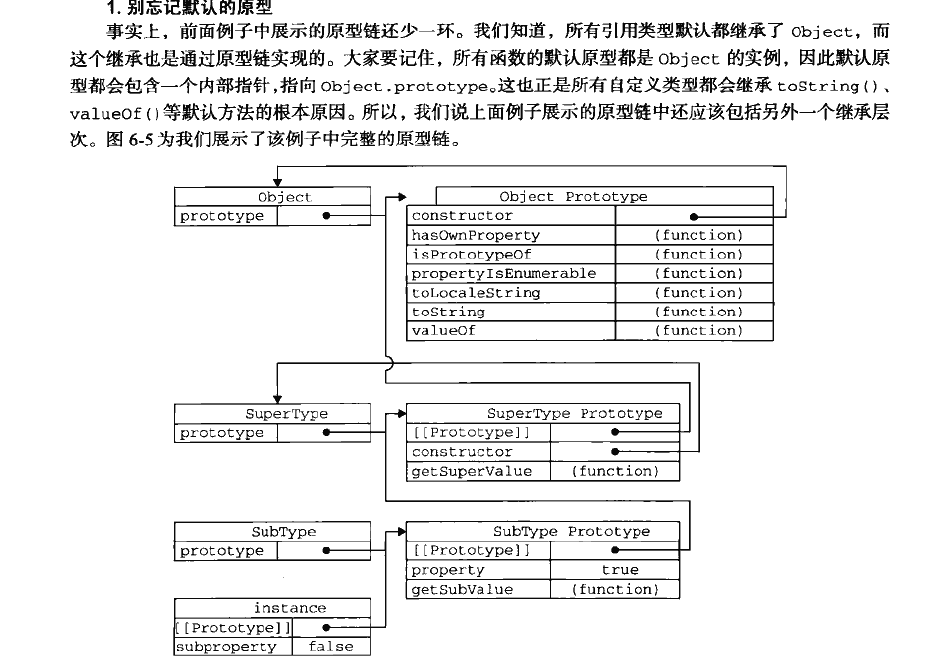JavaScript 面向对象继承详解
题记
由于js不像java那样是完全面向对象的语言,js是基于对象的,它没有类的概念。所以,要想实现继承,一般都是基于原型链的方式;
一、继承初探
大多数JavaScript的实现用 __proto__ 属性来表示一个对象的原型链。
我们可以简单的把prototype看做是一个模版,新创建的自定义对象都是这个模版(prototype)的一个拷贝 (实际上不是拷贝而是链接,只不过这种链接是不可见,新实例化的对象内部有一个看不见的__proto__指针,指向原型对象)
当查找一个对象的属性时,JavaScript 会向上遍历原型链,直到找到给定名称的属性为止。查找方式可以这样表示:
function getProperty(obj, prop) { if (obj.hasOwnProperty(prop)) { return obj[prop]; } else if (obj.__proto__ !== null) { return getProperty(obj.__proto__, prop); } else { return undefined; } }
我们在js中使用面向对象很多时候是这样子的:
function Person(name,age){ this.name = name; this.age = age; } Person.prototype.printInfo = function(){ console.log(this.name + ': ' + this.age); }; var person = new Person('Jack',17); person.printInfo(); // Jack: 17
而变一下,可以发现,这种方式也是可以的
var Person = { /* 声明所需的项 */ name : 'name', age: 'age', printInfo: function(){ console.log(this.name + ': ' + this.age); } }; var person = { name: 'Jack', age: 17, __proto__: Person }; person.printInfo(); // Jack: 17
其实这里就是通过将 __proto__ 指向了Person从而达到了原型继承的目的(这也许也是后续某种继承方式的来源)
以上两种方式是等价的,但我们看到的更多还是new方式来产生实例对象,其实new方式也是通过继承方式实现的,那一个new 究竟做了什么操作呢?
有两个版本,哪个比较中肯就用哪个吧
1)
1、创建一个空对象,并且 this 变量引用该对象,同时还继承了该函数的原型(即把__proto__属性设置为该对象的prototype。
2、属性和方法被加入到 this 引用的对象中(使用apply传参调用)。
3、新创建的对象由 this 所引用,并且最后隐式的返回实例。用代码实现应该就是这样的
/* new Constructor() */ function new (f) { var n = { '__proto__': f.prototype }; /* step 1 */ return function () { f.apply(n, arguments); /* step 2 */ return n; /* step 3 */ }; }
2)
var obj = {}; obj.__proto__ = Base.prototype; Base.call(obj);

不过我用代码实现的时候,两种情况都出现了无线调用堆栈溢出的情况,也许new的操作内部没那么简单




二、继承方式概览
说了那么多new 也乱了,不如直接切入正题,谈谈js流行的几种继承方式
1)对象冒充
对象冒充也分为几类 -- 添加临时属性、apply/call等方式
添加临时属性
缺点是只能继承显示指明的属性,原型上的属性没办法
function Parent(name){ this.name = name; this.words = 'words'; this.say = function(){ console.log(this.name + ': ' + this.words); }; } Parent.prototype.say1 = function(){ console.log(this.name + ': ' + this.words); }; function Child(name){ this.temp = Parent; this.temp(name); // 传参name后即可获取到相应name,words属性,即可销毁temp delete this.temp; } var child = new Child('child'); child.say(); child.say1();

call/apply
实际上是改变了Parent中this的指向,原理跟上个方法一样,但也不能拿到原型的属性
function Parent(name){ this.name = name; this.words = 'words'; this.say = function(){ console.log(this.name + ': ' + this.words); }; } Parent.prototype.say1 = function(){ console.log(this.name + ': ' + this.words); }; function Child(name){ //Parent.call(this,name); Parent.apply(this,[name]); } var child = new Child('child'); child.say(); child.say1();
对象冒充还有一个缺点就是易造成内存的浪费
因为每次冒充的过程都需要实例化一次父对象,而每次实例化的过程,this显示指明的属性将在每个实例中独立存在,不会共用。
比如say()这种方法,每次调用Child都会新产生并。而原型上的say1()方法就可以共用。
2)原型链继承
这种继承方式也许是最常见的了:将父类的新实例赋值给构造函数的原型
function Parent(name){ this.name = name; this.words = 'words'; this.say = function(){ console.log(this.name + ': ' + this.words); }; } Parent.prototype.say1 = function(){ console.log(this.name + ': ' + this.words); }; function Child(name){ this.name = name; } Child.prototype = new Parent();
// 如果不加上这句,Child的constructor就会被Parent的覆盖,变成 Parent Child.prototype.constructor = Child;
var child = new Child('child'); child.say(); child.say1();

可以看到,child不仅可以继承到parent的say()也能拿到say1() ,关键点在于 new Parent()这个new操作
根据最开始我们谈到的new操作,可以知道它具体干了什么
下面来一个变体,这种方式也行,虽然不必在Child中再次定义this.name ,但再次new Child()时,就不能更新我们需要的值。
所以这应该也算是原型链继承的一个不足吧
function Parent(name){ this.name = name; this.words = 'words'; } Parent.prototype.say1 = function(){ console.log(this.name + ': ' + this.words); }; function Child(){} // 直接在参数中写child Child.prototype = new Parent('child'); Child.prototype.constructor = Child; // 这样 newChild就无效了 var child = new Child('newChild'); child.say1(); var p = new Parent(); p.say1(); // child: words
3) 原型链+对象冒充(借用构造函数)
原型链方式和对象冒充方式都各有缺陷,两者的缺陷正是对方的优势。两者一结合,自然又是一个好方法,就叫它组合继承吧。
它背后的思路是 使用原型链实现对原型属性和方法的继承,而通过借用构造函数来实现对实例属性的继承。这样,既通过在原型上定义方法实现了函数复用,又保证每个实例都有它自己的属性。
function Parent(name){ this.name = name; this.words = 'words'; } Parent.prototype.say1 = function(){ console.log(this.name + ': ' + this.words); }; function Child(name){ // 对象冒充 Parent.call(this,name); } // 原型链继承 Child.prototype = new Parent(); Child.prototype.constructor = Child; var child = new Child('child'); child.say1(); // child: words
4)直接继承父类的 prototype
我们知道了原型链的继承是
Child.prototype = new Parent();
那可不可以跳过实例化父类,直接拿Parent的原型呢?
Child.prototype = Parent.prototype;
其实这也是可以的,来看个例子。
function Parent(name){ this.name = name; this.words = 'words'; } Parent.prototype.age = 30; Parent.prototype.sayAge = function(){ console.log(this.age); }; Parent.prototype.say = function(){ console.log(this.name + ': ' + this.words); }; function Child(name){ // Parent.call(this,name); } // 直接继承父类prototype Child.prototype = Parent.prototype; Child.prototype.constructor = Child; var child = new Child('child'); child.say(); // undefined: undefined child.sayAge(); //30
可以看到,这种方式仅仅只能拿到父类的原型属性,实例上的name和words属性就拿不到了。
如果想拿,那就使用Parent.call(this.name)就可以啦。
由此看来,直接用prototype应该会更快,因为不需要像上一个方法那样实例化一个对象耗时。但也是有缺点的。
缺点是 Child.prototype和Parent.prototype现在指向了同一个对象,那么任何对Child.prototype的修改,都会反映到Parent.prototype。
function Parent(name){ this.name = name; this.words = 'words'; } Parent.prototype.age = 30; Parent.prototype.sayAge = function(){ console.log(this.age); }; Parent.prototype.say = function(){ console.log(this.name + ': ' + this.words); }; function Child(name){ Parent.call(this,name); } // 直接继承父类prototype Child.prototype = Parent.prototype; //Child.prototype = new Parent(); Child.prototype.constructor = Child; var child = new Child('child'); child.say(); child.sayAge(); Child.prototype.age = 40; console.log(Parent.prototype.age); // 40
可以看到父级的原型也被更改了,而原型链继承的方式则不会。
但聪明的人类想出了一个好办法:用一个空对象作为中介,再利用操作prototype,
既避免了实例化对象产生太多的耗时,又避免的父子prototype混用的情况。
function Parent(name){ this.name = name; this.words = 'words'; } Parent.prototype.age = 30; Parent.prototype.sayAge = function(){ console.log(this.age); }; Parent.prototype.say = function(){ console.log(this.name + ': ' + this.words); }; function Child(name){ Parent.call(this,name); } // 封装成函数 function extend(Child,Parent){ // 中介对象 function F(){} F.prototype = Parent.prototype; Child.prototype = new F(); Child.prototype.constructor = Child; } // 继承 extend(Child,Parent); var child = new Child('child'); child.say(); child.sayAge(); Child.prototype.age = 40; console.log(Parent.prototype.age); // 30

5)原型式继承
这种继承借助原型并基于已有的对象创建新对象,同时还不用创建自定义类型的方式称为原型式继承。
可以封装成一个方法,这方法其实只做一件事,就是把子对象的prototype属性,指向父对象,从而使得子对象与父对象连在一起。
var Parent = { name : 'parent', words: ['word1','word2'], say: function(){ console.log(this.name + ': ' + this.words); } }; // 封装成方法 Object.create = function(Parent){ function F(){}
// 这里不用F.prototype = Parent.prototype的原因是
// 通过对象字面量定义的Parent对象没有这个直接的prototype属性(属于Object的)
// 如果通过 function Parent()方式定义则可以
F.prototype = Parent; return new F(); }; var Child = Object.create(Parent); Child.say(); Child.name = 'child'; Child.words.push('word3'); Child.say(); Parent.say();

Child继承了父类的属性方法后就可以自行更新属性值或再定义了,不过这里存在一个属性共享问题。
如果是引用类型的数据,比如Object ,就比如Child往words里添加了一项,父类也会被更新,造成某种程度上的问题。
而解决引用类型数据共享问题的方法,一般就是不继承该属性,或者
6)把父对象的属性,全部拷贝给子对象
除了使用"prototype链"以外,还有另一种思路:把父对象的属性,全部拷贝给子对象,也能实现继承。
var Parent = { name : 'parent', words: ['word1','word2'], say: function(){ console.log(this.name + ': ' + this.words); } }; // 对象拷贝函数 function extendCopy(obj){ var newObj = {}; for(var item in obj){ newObj[item] = obj[item]; } return newObj; } var Child = extendCopy(Parent); Child.say(); // parent: word1,word2 Child.name = 'child'; Child.words.push('word3'); Child.say(); // child: word1,word2,word3 Parent.say();// parent: word1,word2,word3
这样的拷贝有一个问题。
那就是,如果父对象的属性等于数组或另一个对象,那么实际上,子对象获得的只是一个内存地址,而不是真正拷贝,因此存在父对象被篡改的可能。
所以上方Child修改之后也会反应到Parent上去。
所以需要进行深度拷贝,一直到拿到真正的值为止
var Parent = { name : 'parent', words: ['word1','word2'], say: function(){ console.log(this.name + ': ' + this.words); } }; // 引用类型 深拷贝函数 function deepCopy(obj,newObj){ newObj = newObj || {}; for(var item in obj){ if(typeof obj[item] === 'object'){ newObj[item] = (Object.prototype.toString.call(obj[item]) === '[object Array]') ? [] : {}; deepCopy(obj[item],newObj[item]); }else{ newObj[item] = obj[item] } } return newObj; } var Child = deepCopy(Parent); Child.say(); // parent: word1,word2 Child.name = 'child'; Child.words.push('word3'); Child.say(); // child: word1,word2,word3 Parent.say();// parent: word1,word2
最后附图两张:








【推荐】国内首个AI IDE,深度理解中文开发场景,立即下载体验Trae
【推荐】编程新体验,更懂你的AI,立即体验豆包MarsCode编程助手
【推荐】抖音旗下AI助手豆包,你的智能百科全书,全免费不限次数
【推荐】轻量又高性能的 SSH 工具 IShell:AI 加持,快人一步
· go语言实现终端里的倒计时
· 如何编写易于单元测试的代码
· 10年+ .NET Coder 心语,封装的思维:从隐藏、稳定开始理解其本质意义
· .NET Core 中如何实现缓存的预热?
· 从 HTTP 原因短语缺失研究 HTTP/2 和 HTTP/3 的设计差异
· 周边上新:园子的第一款马克杯温暖上架
· Open-Sora 2.0 重磅开源!
· 分享 3 个 .NET 开源的文件压缩处理库,助力快速实现文件压缩解压功能!
· Ollama——大语言模型本地部署的极速利器
· DeepSeek如何颠覆传统软件测试?测试工程师会被淘汰吗?